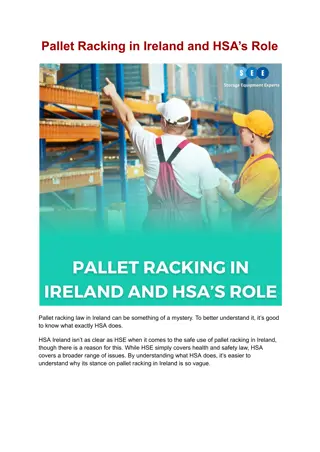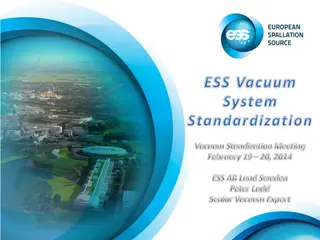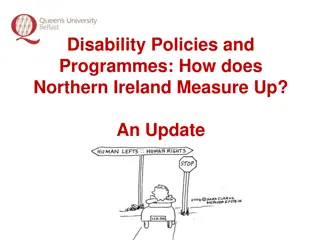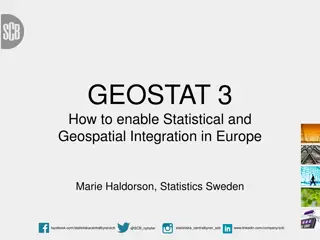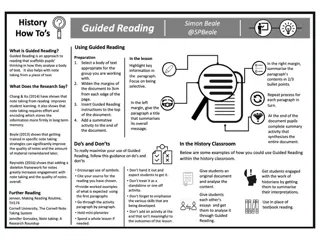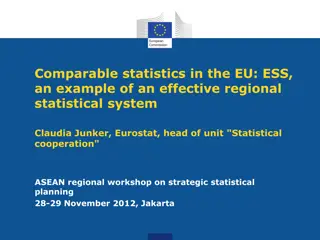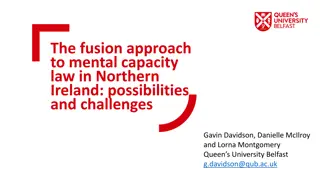
Insights from Employer Skills Survey 2015 in Northern Ireland
Explore findings from the Employer Skills Survey 2015 in Northern Ireland, covering skill shortages, retention challenges, investment in training, and more. Gain valuable insights into high-performance strategies and market practices for businesses.
Uploaded on | 2 Views
Download Presentation

Please find below an Image/Link to download the presentation.
The content on the website is provided AS IS for your information and personal use only. It may not be sold, licensed, or shared on other websites without obtaining consent from the author. If you encounter any issues during the download, it is possible that the publisher has removed the file from their server.
You are allowed to download the files provided on this website for personal or commercial use, subject to the condition that they are used lawfully. All files are the property of their respective owners.
The content on the website is provided AS IS for your information and personal use only. It may not be sold, licensed, or shared on other websites without obtaining consent from the author.
E N D
Presentation Transcript
Employer Skills Survey 2015 Northern Ireland Slide Pack May 2016
2 Contents Background 3 Employers experiences of skill shortages 7 Retention difficulties 17 The internal skills challenge 23 Under-utilisation of skills 34 Employer investment in training and skills 40 High Performance Working Practices and Product Market Strategies 54 Conclusions 59
3 ESS 2015 overview ESS 2015 is the third time the survey has been run at UK-level 4,019 telephone interviews with establishments in Northern Ireland 669 follow up interviews on training spend The 2015 survey covers establishments with 2 or more people working at them The 2011 survey included establishments with one employee these were not covered in 2013 or 2015. Where comparisons are made with 2011 or 2013 findings, these are based on re-weighted 2011 data (configured to represent the 2+ employment business population used in 2013 and 2015).
4 Achieved interviews / confidence intervals For a question asked of all respondents where the survey result is 50%, we are 95% confident that the true figure lies within the range 48.45% to 51.55% (Maximum) Sampling Error Northern Ireland 54,518 4,019 +/-1.55 (Maximum ) Sampling Error Number of interviews PopulationNumber of Population interviews By sector By sector By region By region Agriculture 7,015 84 +/-10.69 Belfast Northern 10,607 12,531 790 925 +/-3.49 +/-3.22 Manufacturing Electricity, Gas and Water Construction 3,178 339 +/-5.32 368 29 +/-18.20 North West 4,813 355 +/-5.20 5,715 246 +/-6.25 Southern 9,458 702 +/-3.70 Wholesale and Retail 11,766 859 +/-3.34 South Eastern 8,872 661 +/-3.81 Hotels & Restaurants Transport and Communications Financial Services 4,063 415 +/-4.81 South West 8,237 586 +/-4.05 2,489 289 +/-5.76 By size of establishment By size of establishment 2-4 29,112 1,168 +/-2.87 1,112 93 +/-10.16 Business Services 6,152 507 +/-4.35 5-24 20,203 2,236 +/-2.07 Public Administration 788 49 +/-14.00 25-49 2,946 321 +/-5.47 Education Health and Social Work Arts and Other Services 3,094 267 +/-6.00 50-99 1,384 191 +/-7.09 4,464 382 +/-5.01 100-249 606 72 +/-11.55 250+ 267 31 +/-17.60 4,314 460 +/-4.57 Population counts taken from IDBR March 2014
5 Profile of survey population Establishments vs. Employment Northern Ireland 53% 28% 72% 2-4 11% 37% 5-24 28% SINGLE SITE MULTISITE 5% 25-49 PRIVATE SECTOR 78% 14% 68% 3% 50-99 13% 14% 3RD 1% 11% SECTOR 100-249 13% PUBLIC SECTOR 7% * * 250+ 22% 20% Data taken from ESS 2015 Base: All establishments (4,019) Data based on IDBR March 2014 counts
6 Key definitions Proportions are based on the number of establishments, defined here as a single location of an organisation, where at least two people work. Establishment base Proportions are based on the total number of employees and working proprietors across establishments. Employment base Vacancies Skill-shortage vacancies Skills gaps Under-utilisation Proportion of establishments with at least one employee deemed by their employer to be not fully proficient in their role Proportion of establishments with at least one employee with skills and qualifications more advanced than required for their current job role Incidence Proportion of establishments reporting at least one skill- shortage vacancy Proportion of establishments reporting at least one vacancy The proportion of all staff with skills and qualifications more advanced than required for their current job role Density The number of staff reported as not fully proficient as a proportion of all employment Vacancies as a proportion of all employment Skill-shortage vacancies as a proportion of all vacancies
7 Section 1: Employers experiences of skill shortages
8 Incidence and density of vacancies by region Incidence of vacancies Density (vacancies as % of employment) 19% 18% 16% 16% 15% 14% 14% 13% 13% 12% 11% 10% 10% 10% 10% 10% 9% 9% 9% 9% 9% 8% 7% 6% 3.7% 3.3% 3.3% 2.9%2.3% 2.4%2.1%2.7% 2.6% 2.6% 2.2%2.4% 1.8%1.7%2.3% 2013 2011 2.5% 2.2%2.1% 1.6%1.9% 1.9% 2013 2011 1.6% 2011 1.4%1.4% 2011 2011 2013 2015 2011 2013 2015 2011 2013 2015 2011 2013 2015 2015 2013 2015 2013 2015 2015 UK Northern Ireland Belfast Northern North West Southern South Eastern South West Base: All establishments (2011: UK: 86,522; Northern Ireland: 3,912; Belfast: 907; Northern: 862; North West: 383; Southern: 650; South Eastern: 667; South West:452 2013: UK: 91,279; Northern Ireland: 4,014; Belfast: 918; Northern: 878; North West: 377; Southern: 644; South Eastern: 688; South West:509 2015: UK: 91,210; Northern Ireland: 4,019; Belfast: 790; Northern: 925; North West: 355; Southern: 702; South Eastern: 661; South West: 586).
9 Incidence and density of vacancies by sector Incidence of vacancies Employers with at least one vacancy (2015) Density (vacancies as % of employment) 200 100 900 800 600 600 400 800 600 1,500 400 100 300 2015 2013 31% 27% 24% 20% 19% 19% 18% 18% 27% 16% 15% 14% 14% 14% 13%13% 13% 12% 10% 9% 7% 5.9% 5%6% 5% 5% 3.9% 3.4% 3.1%3.1% 3.4% 2% 1.3%1.3% 3.1% 2.4%3.1% 2.6% 2.8% 2.5% 2.4% 2.2% 1.4%1.7% 1.8% 1.7%1.9% 2.2% 1.2%1.7% 0.9%0.5% Electricity, Gas & Water Health & Social Work Hotels & Restaurants Business Services Arts & Other Services (460) Wholesale & Retail Agriculture Transport & Comms Education Construction Financial Services Public Manufacturing Administration (49*) (29*) (382) (415) (339) (267) (289) (507) (859) (246) (93) (84) 2015: 2013: (55) (43*) (408) (385) (327) (292) (282) (491) (36*) (866) (259) (112) (133) Base: All establishments (as shown) * Figure should be treated with caution due to low base size (<50)
Incidence and density of skill-shortage vacancies by region 10 SSV Density (SSVs as % of Vacs) 16% 22% 21% 19% 29% 15% 11% 16% 11% 31% 26% 36% 23% 17% 22% 17% 23% 14% 6% 20% 17% 17% 19% 29% Incidence of establishments with vacancies Incidence of establishments with skill-shortage vacancies 19% 18% 16% 16% 15% 14% 14% 13% 13% 12% 11% 11% 8% 10% 10% 10% 9% 9% 9% 9% 9% 8% 7% 6% 6% 5% 4% 3% 3% 3% 3% 3% 3% 3% 3% 3% 3% 3% 3% 3%2% 2% 2% 2% 2% 2% 2% 1% 2011 2011 2013 2015 2011 2013 2015 2011 2013 2015 2011 2013 2015 2013 2015 2011 2013 2015 2011 2013 2015 2011 2013 2015 UK Northern Ireland Belfast Northern North West Southern South Eastern South West Base: All establishments (2011: UK: 86,522; Northern Ireland: 3,912; Belfast: 907; Northern: 862; North West: 383; Southern: 650; South Eastern: 667; South West:452 2013: UK: 91,279; Northern Ireland: 4,014; Belfast: 918; Northern: 878; North West: 377; Southern: 644; South Eastern: 688; South West:509 2015: UK: 91,210; Northern Ireland: 4,019; Belfast: 790; Northern: 925; North West: 355; Southern: 702; South Eastern: 661; South West: 586).
11 Density of skill-shortage vacancies by sector 24% Transport & Comms 200 9% (50) 17% Arts & Other Services 200 28% (69) 17% Business Services 600 16% (90) 17% Hotels & Restaurants 200 33% (90) 16% Manufacturing 400 22% (70) Number of SSVs (2015) 14% Health & Social Work 400 12% (93) 11% Education (54) 100 29% 11% Wholesale & Retail 200 19% (143) Construction ** ** (24**) Public Administration ** ** (15**) 2015 SSV Density 2013 SSV Density Electricity, Gas & Water ** ** (6**) Financial Services ** ** (5**) Base: All establishments with vacancies (only 2015 shown) ** denotes data not shown due to low base size (<25) * Figure should be treated with caution due to low base size (<50) Agriculture ** ** (4**)
12 Density of skill-shortage vacancies by occupation Number of SSVs (2015) 50 600 300 100 400 300 200 400 300 44% 2011 SSV density 2013 SSV density 2015 SSV density 26% 26% 26% 25% 25% 23% 21% 21% 21% 20% 17% 17% 16% 15% 14% 14% 13% 12% 11% 10% 10% 9% 8% 7% 6% ** Managers Professionals Associate Professionals (82) Admin and Clerical (100) Skilled trades Caring, leisure Sales and Cust. Service (69) Machine Operatives (33*) Elementary et al (71) (79) 2011: (32*) (92) (69) (69) 2013: (24) (105) (108) (80) (76) (85) (83) (34*) (131) 2015: (33*) (137) (125) (61) (102) (95) (115) (58) Base: All establishments with vacancies in each occupation (as shown) ** denotes data not shown due to low base size (<25) * Figure should be treated with caution due to low base size (<50)
Technical and practical skills lacking among applicants 13 41% Specialist skills needed for the role 22% 40% Knowledge of how the organisation works 3% 35% Knowledge of the organisation's products and 3% 34% Solving complex problems 1% 33% Complex numerical skills 31% Basic numerical skills 1% 25% Adapting to new equipment 21% Basic IT skills <1% 20% Reading and understanding instructions, 3% 14% Writing instructions, guidelines etc. Skill lacking among any applicants Main skill lacking 13% Manual dexterity 5% 12% Communicating in a foreign language 9% Advanced IT skills 1% Base: All with skill-shortage vacancies that received the new lists of skills descriptors (78)
14 People skills lacking among applicants 47% Ability to manage and prioritise own tasks 13% 41% Customer handling skills 9% 40% Managing or motivating other staff 6% 37% Sales skills 1% 36% Team working 4% 33% Persuading or influencing others <1% 32% Managing their own feelings, or those of others 24% Setting objectives for others and planning 3% 13% Instructing, teaching or training people Skill lacking among any applicants <1% 13% Making speeches or presentations Base: All with skill-shortage vacancies that received the new lists of skills descriptors (78)
15 Impact of skill-shortage vacancies 83% Increase workload for other staff 90% 47% Experience increased operating costs 39% 43% Have difficulties meeting customer services objectives 51% 42% Have difficulties introducing new working practices 49% 2015 2013 40% Have difficulties meeting quality standards 35% 38% Lose business or orders to competitors 42% 34% Delay developing new products or services 52% 29% 27% Have difficulties introducing technological change 26% Outsource work 35% 21% Withdraw from offering certain products or services 33% 92% Any impact 97% Base (2013/2015): All establishments with hard-to-fill vacancies that are all as a result of skill shortages (136/ 162)
16 Action taken to fill skill-shortage vacancies 49% Increasing advertising/ recruitment spend 37% 25% Using new recruitment methods 27% 9% Redefining existing jobs 16% 8% Preparing to offer training to those less well qualified 11% 7% Increasing salaries 4% 7% 7% Recruiting workers who are non-UK nationals 6% Increasing/ expanding trainee programmes 10% 2015 2013 4% Increasing training to existing workforce 12% 3% Using contractors/ contracting out 5% 2% 2% Making the job more attractive <1% Other 2% 12% 13% No action taken Base (2013 / 2015): All with hard-to-fill vacancies (181/ 228)
17 Section 2: Retention difficulties
18 Incidence of retention difficulties - by region Proportion with retention difficulties 10% 8% 8% 7% 7% 6% 6% 10% 3% 8% UK Northern Ireland (2,014) Belfast (414) Northern (468) North West (166) Southern (351) South Eastern (327) South West (288) (45,818) Base: All establishments in Module 2 (as shown)
Incidence of retention difficulties - by establishment size 19 Proportion with retention difficulties 18% 13% 12% 10% 7% 6% 8% ** 2 to 4 (584) 5 to 24 (1138) 25 to 49 (150) 50 to 99 (89) 100-249 (33*) 250+ (20*) Base: All establishments in Module 2 (as shown) * Figure should be treated with caution due to low base size (<50)
20 Incidence of retention difficulties by sector Proportion with retention difficulties 14% 10% 8% 8% 8% 8% 8% 7% 7% 7% 3% 0% * * (36*) (207) (136) (192) (161) (250) (244) (145) (29*) (127) (419) (53) (15**) Base: All establishments in Module 2 (as shown) ** denotes data not shown due to low base size (<25) * Figure should be treated with caution due to low base size (<50)
21 Occupation most affected by retention difficulties Proportion with retention difficulties 26% 15% 14% 12% 9% 8% 5% 4% 0% Managers Professionals Associate Professionals Admin / clerical Skilled Trade Caring / leisure Sales / customer service Machine Ops Elementary / service Base: All establishments with retention difficulties (Module 2: 148)
22 Reasons why it is difficult to retain staff 61% Not enough people interested in doing this type of work 38% Long/unsocial hours 36% Staff don't want long term commitment 36% Impact of the benefits trap 36% Lack of career progression 31% Wages offered are lower than those offered by other organisations 30% Too much competition from other employers 16% Unattractive conditions of employment 15% Geographic location of the site 5% Difficult to find experienced/skilled staff 3% Nature of work is too difficult/mentally and physically tiring 3% Students come and go 2% Cost to employer 8% Other Base: All establishments experiencing retention difficulties (Module 2: 148)
23 Section 3: The internal skills challenge
24 Incidence and density of skills gaps by region Incidence of skills gaps Density (% of all staff with a skills gap) 17% 17% 15% 15% 15% 14% 14% 14% 14% 14% 14% 13% 13% 13% 12% 12% 11% 10% 9% 9% 8.2% 8% 8% 8% 6.9%7.0% 6.0% 5.5%5.2%5.0% 5.3% 5.2% 5.0% 5% 4.6% 4.4% 4.2% 4.0%4.2%3.7% 4.1%3.7% 3.3% 3.5% 3.0% 2.5% 3.0% 2.3% 2011 2013 2015 2011 2013 2015 2011 2013 2015 2011 2013 2015 2011 2013 2015 2011 2013 2015 2011 2013 2015 2011 2013 2015 UK Northern Ireland Belfast Northern North West Southern South Eastern South West Base: All establishments (2011: UK: 86,522; Northern Ireland: 3,912; Belfast: 907; Northern: 862; North West: 383; Southern: 650; South Eastern: 667; South West:452 2013: UK: 91,279; Northern Ireland: 4,014; Belfast: 918; Northern: 878; North West: 377; Southern: 644; South Eastern: 688; South West:509 2015: UK: 91,210; Northern Ireland: 4,019; Belfast: 790; Northern: 925; North West: 355; Southern: 702; South Eastern: 661; South West: 586).
Incidence and density of skills gaps by establishment size 25 46% Incidence of skills gaps 2013 Density (% of all staff with a skills gap) 41% 40% 2011 2015 39% 39% 36% 31% 31% 27% 25% 24% 23% 19% 15% 14% 8% 7% 6.2% 5.9% 5.6% 5.4% 5.8% 5.2% 4.3% 4.5% 3% 1.4% 3.9% 4.5% 4.3% 3.6% 3.5% 3.5% 3.6% 2.9% 3.1% 2011 2013 2015 2 to 4 (989) (2,265) 2013: (1,227) (2,189) 2015: (1,168) 2011 2013 2015 5 to 24 2011 2013 2015 25 to 49 (327) (307) 2011 2013 2015 50 to 99 (185) (167) (191) 2011 2013 2015 100-249 (105) (83) (72) 2011 2013 2015 250+ 2011: (50) (41*) (31*) Base: All establishments (as shown) * Figure should be treated with caution due to low base size (<50) (2,236) (321)
26 Incidence and density of skills gaps by sector Incidence of skills gaps Number of skills gaps (2015) Density (% of all staff with a skills gap) 2,800 7,400 3,200 900 4,000 200 900 2,000 900 600 100 1,000 100 19% 19% 2013 2015 17% 16% 15% 15% 15% 13% 13% 13% 13% 12% 12% 12% 12% 11% 11% 10% 10% 9% 8.0% 8% 7.3% 7% 6.6% 6.6% 6.1% 5.7% 6% 5.9% 5% 5% 4.6% 4.2% 4.2% 4.2% 4.3% 3.3% 4% 3.4% 2.9% 2.8% 2.8% 2.3%1.9% 2.7%2.2% 2.2% 1.8%1.3% 0.8% 0.2% Electricity, Gas & Water (43*) (29*) Public Admin Agriculture Hotels & Restaurants (385) (415) Wholesale & Retail (866) (859) Health & Social Work (408) (382) Business Services (491) (507) Education Financial Services (112) (93) Construction Transport & Comms (282) (289) Arts & Other Services (361) (460) Manufacturing 2013: 2015: (327) (339) (292) (267) (133) (84) (55) (49*) (259) (246) Base: All establishments (as shown) * Figure should be treated with caution due to low base size (<50)
27 Skills gaps density by occupation Number of skills gaps (2015) 24,000 1,500 1,000 700 1,700 1,700 4,100 4,900 4,700 3,800 2013 2015 Density of skills gaps 10.3% 7.3% 6.5% 6.3% 6.0% 5.2% 4.9% 4.6% 4.6% 4.4% 4.5% 4.1% 3.3% 2.4% 2.1% 2.1% 2.1% 1.9% 1.2% 1.2% Northern Ireland Overall (4,014) 2013: 2015: (4,019) Managers Professionals Associate Professionals (51) (28*) Admin and Clerical (167) (117) Skilled trades Caring, leisure et Sales and Cust. Service (207) (163) Machine Operatives (60) (71) Elementary al (152) (94) (72) (42*) (133) (66) (81) (46*) (161) (129) Base: All employment (as shown) * Figure should be treated with caution due to low base size (<50)
28 Impact of skills gaps by establishment size 44% Staff not fully proficient has a minor impact on establishment performance 65% 51% 53% 47% 41% 33% Staff not fully proficient has a major impact on establishment performance 18% 17% 16% 15% 15% ** 0% 0% Northern Ireland Overall 2 to 4 5 to 24 25 to 49 50 to 99 100-249 250+ (520) (36*) (318) (83) (49*) (26*) (8) Base: All with skills gaps (as shown) **denotes data not shown due to low base size (<25) * Figure should be treated with caution due to low base size (<50)
29 Impact of skills gaps Increased workload for other staff 56% Have higher operating costs 32% Have difficulties meeting quality standards 29% Have difficulties introducing new working practices 28% Delay developing new products or services 22% Lose business or order to competitors 21% Outsource work 13% No impact 37% Base: All establishments with skills gaps (520)
Technical and practical skills that need improving among staff with skills gaps 30 54% Specialist skills needed for the role 14% 43% Knowledge of the organisation's products and services 14% 42% Knowledge of how the organisation works 2% 40% Solving complex problems 4% 25% Adapting to new equipment 8% 23% Reading and understanding instructions, guidelines etc 1% 21% Basic IT skills 1% 20% Advanced IT skills 1% 17% Writing instructions, guideline etc. <1% 16% Complex numerical skills 13% Communicating in a foreign language 1% Skill lacking among existing staff 12% Manual dexterity <1% Main skill lacking 12% Basic numerical skills Base: All with skills gaps followed up with the new lists of skills descriptors (271)
People and personal skills that need improving among staff with skills gaps 31 56% Ability to manage and prioritise own tasks 16% 48% Team working 9% 46% Customer handling skills 7% 36% Persuading or influencing others 1% 33% Managing their own feelings, or those of others 5% 31% Managing or motivating other staff 4% 28% Setting objectives for others and planning 1% 27% Sales skills 2% 26% Instructing, teaching or training people Skill lacking among existing staff 3% 22% Making speeches or presentations Main skill lacking <1% Base: All with skills gaps followed up with the new lists of skills descriptors (271)
32 Action taken to overcome skills gaps 67% Increase training activity / spend or increase 58% 49% More supervision of staff 57% 41% More staff appraisals / performance reviews 49% 35% Implementation of mentoring / buddying 40% 30% Reallocating work 38% 27% Changing work practices 2015 2013 30% 16% Increase recruitment activity / spend 13% 12% Recruiting workers who are non-UK nationals 9% 19% Nothing 23% Base (2013 / 2015): All establishments with skills gaps (733/ 520)
Changes in the number of SSVs and skills gaps over time 33 % Change in SSVs since 2013 % Change in Skills Gaps since 2013 114% 111% 81% 23% 19% 12% 8% -18% -16% -23% -29% -26% -30% -29% -29% -38% -40% -47% -48% -40% -51% -55% -59% -79% -95% -100% Public Admin Financial Services Business Services Transport & Comms Electricity, Gas & Water Manufacturin g Health & Social work Agriculture Wholesale & Retail Hotels & Restaurants Arts & Other Services Constructio n Education 2013: 2015: (112) (491) (282) (43*) (327) (408) (133) (866) (385) (361) (259) (292) (55) (93) (507) (289) (29*) (339) (382) (84) (859) (415) (460) (246) (267) (49*) Base: All establishments (as shown) * Figure should be treated with caution due to low base size (<50)
34 Section 4: Under-utilisation
Incidence and density of skills under-utilisation by region 35 Incidence of under-utilisation Skills under-utilisation density 32% 30% 29% 29% 28% 28% 27% 26% 9.6% 8.5% 8.3% 8.0% 7.8% 7.1% 6.7% 6.1% UK Northern Ireland Belfast Northern North West Southern South Eastern South West (91,210) (4,019) (790) (925) (355) (702) (661) (586) Base: All establishments (as shown)
Incidence and density of skills under-utilisation by establishment size 50% Incidence of under-utilisation Skills under-utilisation density 36 45% 40% 41% 38% 35% 33% 33% 30% 31% 25% 26% 20% 15% 15.1% 10% 10.1% 5% 7.5% 7.5% 2.6% 4.7% 0% 2-4 (1,168) 5-24 (2,236) 25-49 (321) 50-99 (191) 100-249 (72) 250+ (31*) Base: All establishments (as shown) * Figure should be treated with caution due to low base size (<50)
Incidence and density of skills under-utilisation by sector 37 Incidence of under-utilisation Skills under-utilisation density 38% 34% 33% 33% 33% 30% 30% 28% 28% 27% 25% 21% 19% 13.2% 12.8% 11.4% 11.3% 9.8% 9.3% 8.2% 7.6% 7.2% 6.5% 6.3% 5.5% 4.0% (246) (382) (29*) (415) (267) (460) (859) (93) (49*) (507) (289) (339) (84) Base: All establishments (as shown) * Figure should be treated with caution due to low base size (<50)
Occupations where under-utilisation is most prevalent 38 13% Elementary staff 29% Managers 2% Machine operatives 11% Sales and customer services 7% Caring, leisure and other 9% Professionals 6% Skilled trade occupations 14% Admin. / clerical 9% Associate Professionals staff Base: All establishments with under-utilised staff (1,223)
Reasons why staff are working in roles for which they have excess qualifications and skills 39 They are not interested in taking on higher level role 24% Lack of jobs in desired higher level role 21% Working hours suit them better 15% To gain experience / current role is lower level in same industry as 10% Attractive conditions of employment 4% Family-run business 4% Competition for higher level roles / struggling to get higher level job 4% Temporary role / stop gap 4% They own the business / are a partner in the business 3% Actively seek staff with quals / skills beyond needs 2% Qualifications / skills not relevant to job role <1% They have more than one job 0% Not particular reason / it just happened 14% Base: All establishments with under-utilised staff (1,223)
40 Section 5: Employer investment in training and skills
Proportion of employers providing training in the last 12 months by region 41 Train Train off-the-job Train on-the-job Train on-the-job only 72% 66% 62% 62% 61% 60% 59% 58% 57% 53% 53% 49% 49% 48% 48% 47% 47% 47% 46% 46% 46% 46% 45% 44% 18% 17% 15% 15% 14% 14% 13% 12% UK Northern Ireland (4,019) Belfast Northern North West Southern South Eastern South West (91,210) (790) (925) (355) (702) (661) (586) Base: All establishments (as shown)
Proportion of employers providing training in the last 12 months by size 42 Train Train off-the-job Train on-the-job Train on-the-job only 100% 96% 94% 94% 91% 88% 88% 85% 83% 81% 77% 76% 75% 60% 58% 47% 34% 34% 17% 17% 15% 14% 13% 13% 2-4 (1,168) 5-24 (2,236) 25-49 (321) 50-99 (191) 100-249 (72) 250+ (31*) Base: All establishments (as shown) * Figure should be treated with caution due to low base size (<50)
Proportion of employers providing training in the last 12 months by sector 43 Train Train off-the-job Train on-the-job Train on-the-job only 92% 89% 85% 84% 79% 77% 77% 75% 74% 72% 70% 66% 65% 64% 61% 61% 60% 58% 58% 58% 55% 54% 54% 53% 50% 47% 47% 46% 46% 44% 44% 43% 40% 39% 38% 38% 31% 30% 25% 20% 20% 18% 17% 15% 15% 15% 14% 14% 14% 11% 8% 7% Manufacturin g Constructio n Education Electricity, Gas etc. Health and Social Work Public Admin Financial Services Hotels & Restaurants Transport & Comms. Wholesale & Retail Business services Arts and Other Agriculture (507) (415) (339) (289) (246) (859) (382) (49*) (93) (29*) (84) (267) (460) Base: All establishments (as shown) * Figure should be treated with caution due to low base size (<50)
Training Equilibrium: employers interest in providing more training than they were able to 44 of all employers train don t train 62% 38% Among those who train Among those who don t train (Base: 2,869) (Base: 1,150) 34% 66% 47% 51% 2% Wanted to train Wanted to train more Did not want to train Do sufficient training Don t know 43% 57% of employers want to train more of employers in training equilibrium (no desire to increase training) *Note training employers responding Don t know have been included in the group Wanted to undertake more training on final measure Base: All establishments (4,019)
Types of Training and Workforce Development provided 45 Job specific training 82% Health and safety / first aid training 78% Basic induction 61% Any induction 63% Training in new technology 50% Management training 35% Proportion providing each type of training Supervisory training 35% More extensive induction 33% Base (2015): All establishments that train (2,869)
46 Number and proportion of staff trained by region Total number of staff trained (thousands) 2011 2013 2015 14.7m 60 42 433 426 142 146 150 92 85 107 40 34 36 62 51 68 51 66 46 44 16.8m 17.4m 463 Proportion of staff trained 70% 67% 66% 64% 64% 64% 63% 62% 61% 61% 60% 59% 59% 56% 56% 56% 55% 55% 55% 55% 54% 53% 49% 47% UK Northern Ireland Belfast Northern North West Southern South Eastern South West (86,522) (3,912) (907) (862) (383) (650) (667) (452) 2011: 2013: 2015: (91,279) (91,210) (4,014) (918) (878) (377) (644) (688) (509) (4,019) (790) (925) (355) (702) (661) (586) Base: All establishments (as shown)
47 Proportion of staff trained by size 77% 2011 2013 2015 72% 71% 67% 65% 65% 63% 60% 60% 60% 58% 58% 56% 55% 54% 52% 43% 36% 2-4 (989) 5-24 (2,265) 25-49 (327) 50-99 (185) 100-249 (105) 250+ (50) 2011: 2013: 2015: (1,227) (2,189) (307) (167) (83) (41*) (1,168) (2,236) (321) (191) (72) (31*) Base: All establishments (as shown) * Figure should be treated with caution due to low base size (<50)
48 Number and proportion of staff trained by sector Total number of staff trained 2015 6k 47k 14k 71k 25k 22k 8k 73k 37k 42k 94k 18k ** 2011 2013 2015 Proportion of staff trained 84% 82% 80% 78% 76% 74% 73% 71% 70% 68% 65% 63% 63% 63% 62% 61% 62% 58% 57% 55% 55% 54% 54% 53% 52% 52% 51% 50% 49% 49% 48% 47% 47% 43% 41% 27% 27% ** ** 2011: 2013: 2015: (32*) (358) (54) (364) (724) (334) (290) (137) (509) (105) (285) (417) (312) (133) (327) (43*) (259) (866) (385) (282) (112) (491) (55) (292) (408) (361) (84) (339) (29*) (246) (859) (415) (289) (93) (507) (49*) (267) (382) (460) Base: All establishments (as shown) **denotes data not shown due to low base size (<25) * Figure should be treated with caution due to low base size (<50)
49 Proportion of staff trained by occupation 2011 2013 2015 Proportion of staff trained 79% 79% 78% 76% 76% 73% 70% 64% 64% 63% 62% 61% 60% 58% 57% 55% 55% 54% 53% 52% 52% 52% 48% 48% 47% 47% 46% Managers Professionals Assoc. Admin / clerical Skilled Trades Caring, Leisure, Other services (550) Sales & Customer service (1,116) Machine operatives (612) Elementary Professionals (544) 2011: (3,718) (718) (2,403) (900) (1,240) 2013: (3,789) (757) (671) (2,357) (915) (613) (1,156) (575) (1,339) 2015: (3,733) (713) (442) (2,338) (802) (688) (1,230) (599) (1,216) Base: All establishments with staff in each occupation (as shown)
50 Training Days Days per person trained Total training days % increase from 2013 2011 2013 2015 2011 2013 2015 UK 7.8 (66,916) 6.7 (69,842) 6.8 (69,541) 115m 113m 118m +4% Northern Ireland 6.3 (2,903) 6.3 (2,894) 5.6 (2,869) 2.7m 2.7m 2.6m -4% Belfast 6.0 (721) 5.3 (705) 4.9 (606) 0.8m 0.8m 0.7m -5% Northern 7.3 (628) 6.9 (621) 5.0 (654) 0.7m 0.6m 0.5m -8% North West 5.6 (289) 6.5 (275 5.3 (256) 0.2m 0.2m 0.2m -15% Southern 5.3 (481) 5.5 (435) 6.5 (494) 0.3m 0.3m 0.4m +58% South Eastern 7.3 (462) 6.1 (500) 5.4 (448) 0.4m 0.4m 0.3m -24% South West 5.9 (322) 9.7 (358) 8.7 (411) 0.3m 0.4m 0.4m -9% Base: All establishments providing training (as shown)

